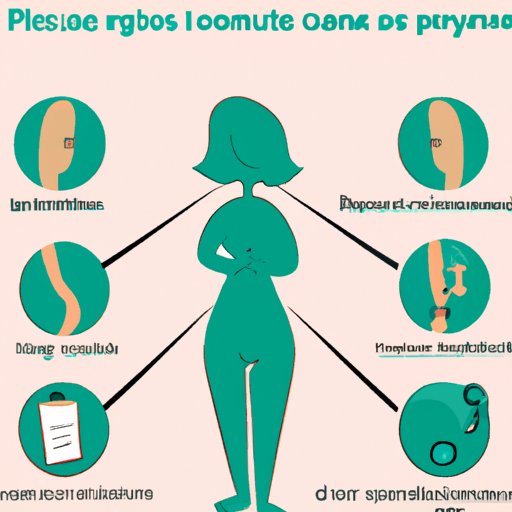
I. Introduction
PCOS, or Polycystic Ovary Syndrome, is a hormonal disorder that affects up to 10% of women of reproductive age. It is characterized by a range of symptoms, including irregular periods, acne, weight gain, and fertility issues. Recognizing the signs of PCOS is crucial for early diagnosis and treatment. In this article, we’ll explore the symptoms of PCOS, how it’s diagnosed, and the various treatment options available.

II. Symptoms of PCOS: How to Recognize the Signs
The most common symptoms of PCOS include:
- Irregular periods
- Acne
- Weight gain or difficulty losing weight
- Excessive hair growth on the face, chest, or back
- Thinning hair or hair loss on the scalp
- Darkening of skin in the armpits, neck, or groin
While not all women with PCOS experience every symptom, these are some of the most commonly reported ones. Each symptom is related to PCOS in different ways. For instance, irregular periods occur when the ovaries produce too much androgen, a male hormone, which interferes with ovulation. Excessive hair growth and acne are also caused by high levels of androgen. Weight gain and difficulty losing weight are due to insulin resistance, a common factor in PCOS.
III. The Uncomfortable Truth: PCOS and Its Symptoms
PCOS can take both an emotional and physical toll on those who suffer from it. Women with PCOS often experience anxiety, depression, and low self-esteem due to their symptoms. They may also feel embarrassed or ashamed about excessive hair growth or acne.
“It’s hard to feel confident in yourself when you don’t recognize the person looking back at you in the mirror,” says Sarah, who was diagnosed with PCOS in her early 20s. “It’s frustrating because it feels like my body is constantly working against me.”
Many women with PCOS struggle to lose weight, which can exacerbate their symptoms. “I’ve been dieting and exercising for months, but the weight just won’t come off,” says Rachel, another PCOS sufferer. “It’s like my body is holding onto every calorie.”
IV. PCOS Diagnosis: Understanding the Tests and Criteria
Diagnosing PCOS can be tricky because the symptoms can vary widely from person to person. Doctors typically start by taking a medical history and conducting a physical exam, including a pelvic exam to check for cysts on the ovaries. They may also order blood tests to check hormone levels and glucose tolerance.
There are a few different criteria that doctors use to make a diagnosis of PCOS. The Rotterdam criteria require the presence of at least two out of three symptoms: irregular periods, excess androgen, and cysts on the ovaries. The Androgen Excess Society criteria require the presence of both excess androgen and either irregular periods or cysts on the ovaries. The National Institutes of Health criteria require the presence of excess androgen and irregular periods.
V. PCOS and Infertility: What You Need to Know
PCOS is a leading cause of infertility in women. When PCOS interferes with ovulation, it can be difficult to conceive. However, there are treatment options available for women struggling with infertility due to PCOS. One of the most common treatments is medication to induce ovulation, such as clomiphene citrate or letrozole. In more severe cases, in vitro fertilization (IVF) may be necessary.
VI. Hidden Dangers of PCOS: Risks and Complications
PCOS is not just a reproductive disorder; it can also increase the risk of certain health complications. Women with PCOS are at higher risk for:
- Cardiovascular disease
- Type 2 diabetes
- Endometrial cancer
- Depression and anxiety
These risks develop due to the combination of insulin resistance, hormonal disruptions, and inflammation that are common in PCOS. However, there are steps that women with PCOS can take to reduce their risk of these complications, including maintaining a healthy weight, eating a balanced diet, and staying active.
VII. Understanding PCOS: A Comprehensive Guide
PCOS is a complex disorder that involves dysfunction in the endocrine system, which produces and regulates hormones. The ovaries produce androgens, but when the body produces too much androgen, it interferes with ovulation and can cause a range of symptoms.
There is no known cure for PCOS, but there are various treatment options available to manage the symptoms. Lifestyle modifications, such as diet and exercise, are often the first line of defense. Medications, including birth control pills and diabetes drugs, can also help regulate hormone levels and manage symptoms.
VIII. Living with PCOS: Coping Strategies and Treatment Options
Living with PCOS can be challenging, but there are strategies that can help manage the symptoms. Exercise is one of the most effective ways to improve insulin resistance and regulate hormone levels. Eating a balanced, low-glycemic diet can also help manage weight and reduce insulin resistance.
Some women may also benefit from medication, such as birth control pills or anti-androgens. Birth control pills can regulate menstrual cycles and reduce the risk of endometrial cancer. Anti-androgens, such as spironolactone, can reduce acne and excess hair growth.
IX. Conclusion
PCOS is a complex disorder that can be difficult to diagnose and manage. However, early diagnosis and treatment can make a big difference in managing symptoms and reducing the risk of health complications. If you’re experiencing symptoms of PCOS, talk to your doctor about getting tested and developing a treatment plan that works for you.
With the right support and treatment, it is possible to live a happy, healthy life with PCOS.




